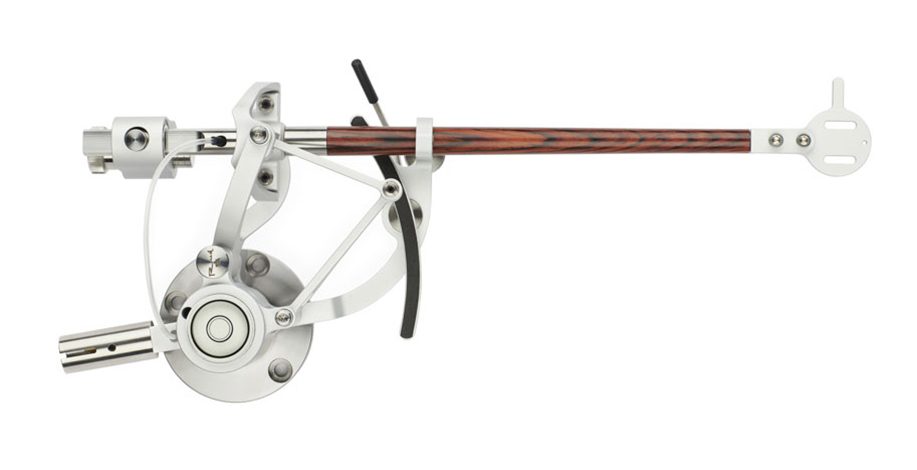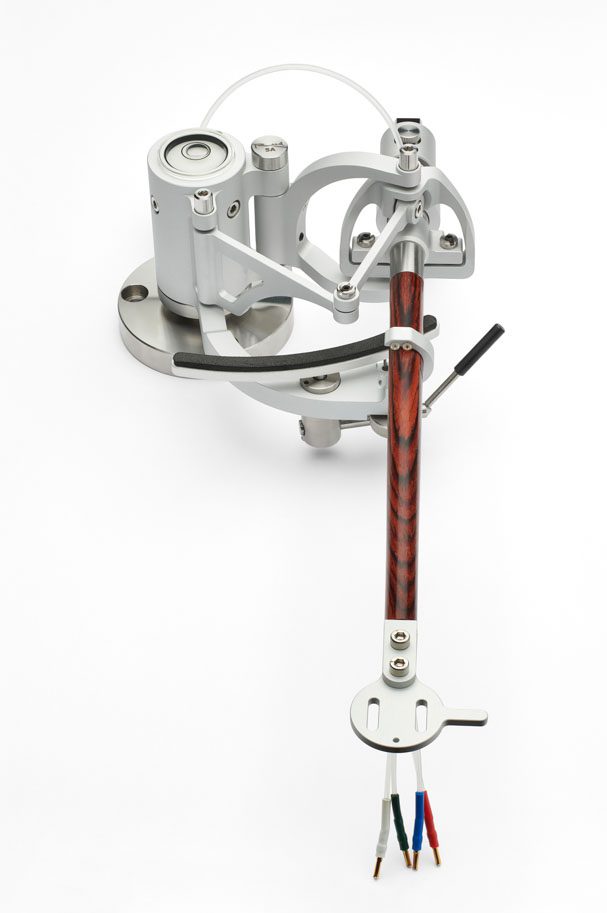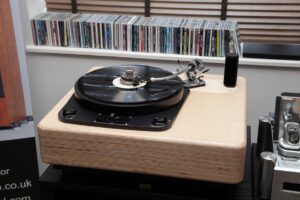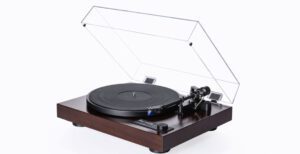
Some think that all turntable design is just ‘refinement’ now. The turntable as we know it was patented by Emile Berliner back in 1887, so that notion is understandable. But even 136 years later, there are still innovations that can surprise. The Reed 5A tonearm is one of those innovations.
Reed is the brainchild of Lithuanian turntable and tonearm expert, Vidmantas Triukas. The Reed 5A first saw light of day in prototype form at the Audio Gourmet show in Vilnius in 2019. It’s described as a ‘Tangential 90 Degree Pivot Reference’ tonearm and is based on a Double Birch/Thales geometry.
With a hefty degree of understatement, the company almost dismisses the 5A, saying it “will complement our tangential tonearm lineup.” That’s notionally true when you have the laser-guided tangentially tracking pivoted Reed 5T tonearm in the range. But I think, most companies would be shouting louder about the Reed 5A.
Translating from classical Geek
The idea of ‘tangential tracking’ and ‘pivoted’ in the same tonearm might read like an oxymoron. In fact, a part of the secret to combining the two even predates Emile Berliner’s patents… by about 2,500 years. The ‘Thales’ part of ‘Double Birch/Thales’ above uses the geometric theorem of classical Greek philosopher and mathematician Thales of Miletus. Couple ‘Double Birch’ calculations with Thales’s theorem and you create an arm that is always at 90° to the groove. Geek out to that, vinylistas!
I don’t think you can step far from the mathematics in this tonearm design. The engineering of the Reed 5A looks like the geometry in mechanical form. Looking from the front of the turntable, the tonearm sits forward and to the right of its base. This armtube, intelligent counterweight and bearing all connect to that base by what looks like a pantograph. The pivot point of the tonearm describes an arc, leaving the cartridge to track tangentially to the groove.
Sharing Clever
This clever tangential arrangement is shared only with the top-end Reed 5T, but that’s just the start. The tonearm sports a low-noise ceramic rolling bearing on its back link that rests on a sapphire/molybendum carbide thrust bearing. The front link, vertical and horizontal axes also use sapphire/molybendum carbide thrust bearings.
All this could make the tonearm impossible to set-up, but it also includes an integrated level and horizontal plane adjuster. Any potential compliance mismatches can be ironed out by fine-tuning your choice of arm-wand. This means the five different wood samples are not just for show, although it looks great in Wenge!
For all its options and seeming complexity, the Reed 5A is not difficult to set-up. It’s a painstaking process more than a frustrating one. However, your past ‘form’ in setting up cartridges can be a hinderance if it generates siloed thinking. Instead, think of this as an exercise in practical mathematics, but without the programmable calculator.
First Rate
A Reed 5A is going to need a first-rate turntable, cartridge, and phono stage. That doesn’t mean it hides its quality unless partnered with the best. But you are going to want everything else delivering the same high calibre of performance throughout. This often means the Reed 5A will be the cheapest link in the chain, by far. Naturally, the Reed Muse 3C (that we tested back in issue 141) is a natural partner. But it’s also commonly used with a Döhmann Helix One turntable, and the 5A is a tenth of the price. A sure sign of the Reed 5A’s quality is you’ll never notice.

In fact, you’re more likely to notice just how good your other original vinyl equipment choices were. Having freed turntable, cartridge, and phono stage from the tonearm’s sonic logjam, the Reed 5A lets loose their potential. With the best components, that revelation is extremely powerful.
Pushing is such a drag
Unlike other parallel tracking tonearms, the Reed 5A comes without the inherent ‘pushing’ or ‘dragging’ effects. While these effects can be reduced to negligible levels, thanks to near-frictionless air bearings, they are never fully removed. By re-writing tonearm design in this manner, Reed manages to combine the best of both worlds. The Reed 5A combines the freedom, rhythm, and dynamics of a unipivot with the detailed neutrality of a parallel tracker. It even has the bass energy, drive and slam of a conventional gimbal-bearing tonearm.
Around now, you might be thinking of the old figure of speech, “Jack of all trades, master of none.” That doesn’t apply to the Reed 5A. The first record you play – in my case Norman F***ing Rockwell by Lana Del Ray [Polydor] – sets the tone. The Reed 5A does everything exceptionally well, from the strings played in the intro to the last bars. Her voice is exceptionally well portrayed, articulate and solid in centre stage. Everything in the mix stands in its own space too.
No distortion
You are going to play an album you know well right the way through. This isn’t intended as a test to check start-of-side and end-of-side distortion. It’s more that you wanted to hear the album from beginning to end. But it turns into a test of start/end-of-side distortion anyway. This is because maybe for the first time you get to hear records without that distortion. And it floors you. The recording sounds more like the master tape. Except even master tape can stretch; so, this sounds like the master tape when first played back.
My acid test for this is that famous ‘The End’ montage at the close of The Beatles Abbey Road [Apple]. This takes on a quality at once luminous and solid that you rarely hear on the LP. Yes, it means Ringo’s famous drum solo and George’s clever guitar parts shine through; but they always do. Instead, it’s the whole crescendo and wall of sound, which makes a bit more sense here. I’ve been listening to that album for decades, all the time listening to distortion that just went away!
In an analogue world, digital has spoiled us a little. We love vinyl for its sound quality, but sometimes wish it was more precise and less distorted. However, CD and streaming are arguably more accurate but less enjoyable. The Reed 5A simply wipes away those vinyl limitations. In the process, it makes digital, open-reel and other vinyl systems appear more of a compromise than LP replay.
Picking holes
Reviewers should pick holes in the performance of a product, but such holes are nuances at best here. Arguably, the bass depth and slam are not quite as good as you get from the very best conventional tonearms. Also, those wedded to the sound of a particular tonearm might not like the Reed 5A. Here, I’m thinking specifically of old-school Naim Aro users who love its characteristics so much that anything else is ‘wrong’.
The only real strike against the Reed 5A is at best reaching. It’s the way you move the tonearm and cartridge into place. We are all used to lifting the headshell and gently lowering the cartridge on to the groove. The Reed 5A works better when moved into place and using the lift/lower arm. However, the precision with which you can put the needle into the groove is outstanding. The days of missing the intro or outro of a track are all but over with the Reed 5A.
World of Wonder
There is another downside if you can even call it that. Sometime through your listening session, you’ll say to yourself “I wonder…” The world of the larger, more elaborate, and more expensive Reed 5T with its (literally) laser-guided precision is calling. It might just start chipping away at your Audiophile Expenditure Defence Shield. But there’s really no need with Reed! While this doesn’t wipe out all other tonearms at a single stroke, it calls into question most top-end tonearms. The best remain competitive, but there’s not much at even 1.5x its price that challenges the Reed 5A.
I’ve failed. I’ve tried to explain just how the Reed 5A works without diagrams. It turns out, that’s as easy as juggling sand. But, put simply; clever thing makes records sound great. Although the engineering is first rate, there’s nothing on the Reed 5A that couldn’t have been made decades ago. The fact no one did is a testament to Reed’s mathematical smarts. It also shows there’s still things to be uncovered from good vinyl. And best of all, that good vinyl sounds amazing played through the Reed 5A tonearm.
Technical specifications
- Type: Tangential pivoted tonearm
- Mounting distance: 251 mm (330mm max. platter diameter)
- Tracking error: ±4 Minutes of Angle (MOA)
- Effective mass: 10g–16 g depending on arm-wand material
- Height adjustment: Compatible with 26 - 46 mm height platters
- VTA adjustment precision: ± 0.2 mm
- Azimuth adjustment: ± 8°
- Downforce range:10–30 Nm (cartridge mass 5.5 g–19.5 g, (4.0 g–25,0 g))
- Offset angle, overhang: 0°, 0mm
- Integrated level, accuracy: ± 2mm/m
- Finish: Seashell white/Black (arm base, counterweight et, al)
- Arm-wood options: Wenge, Macassar Ebony, Cocobolo, light and dark Teak
- Price: £7,798
Manufacturer
Reed
www.reed.lt
UK distributor
Absolute Sounds
+44(0)208 971 3909
By Alan Sircom
More articles from this authorRead Next From Review
See all
PrimaLuna EVO 100 phono preamplifier
- Apr 22, 2024

Reiki Audio SuperSwitch Master Pro + Servant Pro
- Mar 27, 2024

Melco Audio N1-S38 music server
- Mar 27, 2024











